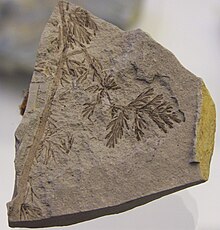| Lyginopteridales Temporal range:
| |
|---|---|

| |
| Diplopteridium holdenii, Early Carboniferous Drybrook Sandstone, Forest of Dean, UK. | |
| Scientific classification | |
| Kingdom: | Plantae |
| Clade: | Tracheophytes |
| Division: | †Pteridospermatophyta |
| Class: | †Lyginopteridopsida |
| Order: | †Lyginopteridales |
| Families | |
The Lyginopteridales are an extinct group of seed plants known from the Paleozoic. They were the first plant fossils to be described as pteridosperms (a polyphyletic group sometimes referred to as "seed ferns") and, thus, the group on which the concept of pteridosperms was first developed;[2] they are the stratigraphically oldest-known pteridosperms, occurring first in late Devonian strata;[3] and they have the most primitive features, most notably in the structure of their ovules.[4] They probably evolved from a group of Late Devonian progymnosperms known as the Aneurophytales,[5] which had large, compound frond-like leaves. The Lyginopteridales became the most abundant group of pteridosperms during Mississippian times, and included both trees[6] and smaller plants.[3] During early and most of middle Pennsylvanian times the Medullosales took over as the more important of the larger pteridosperms but the Lyginopteridales continued to flourish as climbing (lianescent) and scrambling plants. However, later in Middle Pennsylvanian times the Lyginopteridales went into serious decline, probably being out-competed by the Callistophytales that occupied similar ecological niches but had more sophisticated reproductive strategies. A few species continued into Late Pennsylvanian times, and in Cathaysia and east equatorial Gondwana they persisted into the Late Permian, but subsequently became extinct.[7] Most evidence of the Lyginopteridales suggests that they grew in tropical latitudes of the time, in North America, Europe and China.
- ^ Anderson, J.M., Anderson, H.M, & Cleal, C.J. (2007). "Brief history of the gymnosperms: classification, biodiversity, phytogeography and ecology". Strelitzia. 20: 1–280.
{{cite journal}}: CS1 maint: multiple names: authors list (link) - ^ Oliver, F. W. & Scott, D. H. (1904). "On the structure of the Palaeozoic seed Lagenostoma Lomaxi, with a statement of the evidence upon which it is referred to Lyginodendron." Philosophical Transactions of the Royal Society of London, Series B, 197: 193-247.
- ^ a b Rothwell, G. W., Scheckler, S. E. & Gillespie, W. H. (1989). "Elkinsia gen. nov., a Late Devonian gymnosperm with cupulate ovules." Botanical Gazette, 150: 170-189.
- ^ Long, A. G. (1959). "On the structure of Calymmatotheca kidstoni Calder (emended) and Genomosperma latens gen. et sp. nov. from the Calciferous Sandstone Series of Berwickshire." Transactions of the Royal Society of Edinburgh, 64: 29-44.
- ^ Rothwell, G. W. & Erwin, D. M. (1987). "Origin of seed plants: an aneurophyte/seed-fern link elaborated." American Journal of Botany, 74: 970-973.
- ^ Long, A. G. (1979). "Observations on the Lower Carboniferous genus Pitus Witham." Transactions of the Royal Society of Edinburgh, 70: 111-127.
- ^ Zavialova, Natalia; Blomenkemper, Patrick; Kerp, Hans; Hamad, Abdalla Abu; Bomfleur, Benjamin (2021-03-04). "A lyginopterid pollen organ from the upper Permian of the Dead Sea region". Grana. 60 (2): 81–96. Bibcode:2021Grana..60...81Z. doi:10.1080/00173134.2020.1772360. ISSN 0017-3134. S2CID 224931916.